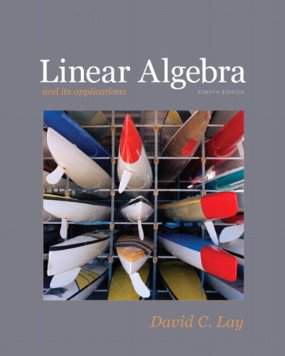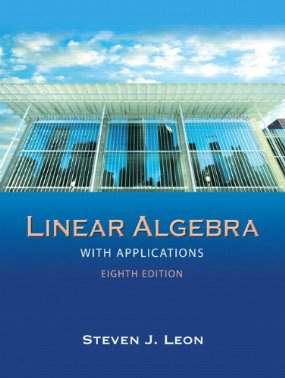Connecting...

This is a quick preview of the lesson. For full access, please Log In or Sign up.
For more information, please see full course syllabus of Linear Algebra
For more information, please see full course syllabus of Linear Algebra
Linear Algebra Subspaces
Lecture Description
Continuing our lesson on vector spaces will lead us to the notion of vector subspaces and linear combinations. Essentially what you’ll be dealing with here is more rule-checking like we did last time. A space can only be a subspace if it follows specific rules set by the vector space. Things may seem confusing now, but once you apply this knowledge to some examples you’ll quickly develop a way to view spaces/subspaces in your own way. Additionally, we’ll discuss combining vectors in a space, and what applications that new vector has. After this we’ll get a breather from the technicalities of proofs, and jump into a topic with more math than words.
Bookmark & Share
Embed
Share this knowledge with your friends!
Copy & Paste this embed code into your website’s HTML
Please ensure that your website editor is in text mode when you paste the code.(In Wordpress, the mode button is on the top right corner.)
×
Since this lesson is not free, only the preview will appear on your website.
- - Allow users to view the embedded video in full-size.
Next Lecture
Previous Lecture










































 Answer Engine
Answer Engine




1 answer
Sat Apr 12, 2014 5:24 PM
Post by Kasun Jayasuriya on April 7, 2014
Wow. These lectures and examples are really good. I have just one month for my exams and I haven't understood any of this till now because university lectures are completely useless. I am really glad that I found this at least just before my exams. This really helps. Thanks a lot.
0 answers
Post by Burhan Akram on November 8, 2013
Hello Professor Raffi,
Very good explanation of subspaces. However, I have a question about one subspace. How would you approach this to show whether it's a subspace or not. Here is it, " subset of all polynomials in P5 for which p(1)=p(3)"....how would you tackle this problem? Thanks again, your lectures are very helpful.
4 answers
Wed Sep 25, 2013 4:19 PM
Post by Christian Fischer on September 24, 2013
Hi Raffi, Once again: Great video. I want to make sure I understood the conclusion to example 2 100%. Can you clarify that this is correct?
So w is a subspace of the Vector space V because:
A)The subset (a,b,0) satisfies the list of operations for vector spaces (closure etc.) when applying the 2 operations (+) and (*)
B)When testing for closure the vector A1+A2=(a1+a2,b1+b2,0) Is of the same form, so if we ended up with a non-zero z-cordinate it would be outside of the subset and therefore the subspace is not a vectorspace.
Can you say R^3 alone is a vector space? Does it mean that every vector in R^3 is a vector space? And so R^2 is a subset of R^3 but not vice versa.
Have a great day
Christian
0 answers
Post by Professor Hovasapian on June 18, 2013
Hi Manfred,
Thank you so much for the kind words -- they truly mean a lot to me. I'm thrilled that Mathematics is beautiful to you; and I'm happy we can bring some of this beauty to you in our courses and lessons.
Have fun.
Raffi
0 answers
Post by Manfred Berger on June 15, 2013
Just when I thought the lecture was losing a bit of momentum, you pull a VS from the polynomial ring, and have my full attention back in an instant. You probably get messages like this all the time, but: You're just an awesome instructor!
4 answers
Sun Mar 24, 2013 6:10 PM
Post by Professor Hovasapian on March 23, 2013
Hi Matt,
I you're doing well.
When a set is closed under addition, this means that if I take two elements from that set and add them, the result is yet another element in that set. For example, the set of even numbers: if I take any two even numbers and add them, the result is always an even number -- so the even numbers are closed under addition. Now let's take the odd numbers: if I add any two odd numbers, I get an even number -- the result of the addition lands me outside the set of add numbers -- so the odd numbers are NOT closed under addition.
Now, this question. Our set is given, and the two elements are the vectors (a, a-2) & (b,b-2). When I add these I get the (a+b, a+b-4). Does it make sense how we got this?
The question is: Is this result vector in the original set? The first component is a+b. Let's call this M. The second component is a+b-4. Let's call this M-4. Now we have (M,M-4).
Does this last vector look like it belongs to the original set? NO -- because any vector in the original set has to be of the form (P, P-2). When we added we got (m, M-4) -- we landed outside of the set -- therefore NOT closed under addition...therefore, NOT a Subspace.
I hope this made sense. Please let me know if it did not, and I will prepare a short document for you with other examples and upload it to my "Linear Algebra for Educator.com" Group page on Facebook:
https://www.facebook.com/groups/344583348957004/
Best wishes, and take good care
Raffi
1 answer
Sat Mar 23, 2013 5:16 PM
Post by Matt Cypert on March 23, 2013
Hello,
V=R^2. If I had a subset S = {(x,x-2): x∈R} is it a subspace of V.
First I use addition
u = (a, a-2)
v = (b, b-2)
u+v = (a+b, a + b - 4). The book says it is not closed under addition, therefore it is not a subspace, but it does not go into any detail as to why. In all your examples they seemed to all work out or be a subspace. Could you possibly explain to me why this is not closed under addition making it not a subspace?
1 answer
Wed Jan 23, 2013 3:52 AM
Post by Hai Lieu on January 22, 2013
Hello Pro. Professor Hovasapian,
Thanks for a quick respond for the above question. So, if a 2x2 matrix A is given. How do we find A-invariant subspaces?
Thanks
Hai
2 answers
Tue Jan 22, 2013 9:27 PM
Post by Hai Lieu on January 22, 2013
Does anyone know the different between A-invariant subspace and subspace? I don't see any lesson regarding A-invariant subspace.
Thank you in advance
1 answer
Tue Nov 20, 2012 6:52 PM
Post by Brodey Hansen on November 20, 2012
My professor should watch these lectures so he can learn how to TEACH!
1 answer
Sun Aug 5, 2012 7:52 PM
Post by hasan dilek on August 5, 2012
great lectures, good examples. it feels like the lectures at uni are completely useless.
0 answers
Post by Talwar Chanonia on November 18, 2011
Thankyou!!